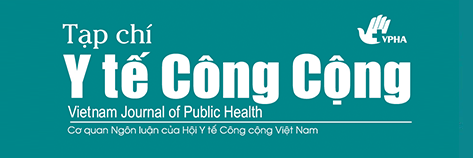Tỷ lệ thiếu máu ở phụ nữ có thai tại một số xã huyện Quỳnh Phụ, Thái Bình năm 2012 (Anemia rate in pregnant women in some communes of Quynh Phu district, Thai Binh province in 2012)
Tóm tắt
Thiếu máu ở phụ nữ, đặc biệt phụ nữ có thai là vấn đề có ý nghĩa sức khỏe cộng đồng ở Việt Nam. Mục tiêu: xác định tỷ lệ thiếu máu ở phụ nữ có thai từ 13-24 tuần. Nghiên cứu cắt ngang mô tả trên 143 phụ nữ có thai (PNCT). Kết quả: giá trị trung bình Hb của PNCT theo nhóm tuổi thai cao nhất là ở nhóm 13-16 tuần (120,1 ± 9,6), cao hơn có ý nghĩa thống kê (p < 0,05) so với nhóm tuổi thai 17-20 tuần (115,7± 8,2) và 21-24 tuần (114,7 ± 8,9). Tỷ lệ thiếu máu của PNCT 13-24 tuần thai là 27,3%. Tuổi thai từ 13-16 tuần có tỷ lệ thiếu máu thấp nhất (25%) và khi tuổi thai từ 21-24 tuần phụ nữ bị thiếu máu cao nhất (28,8%). Tỷ lệ thiếu máu của phụ nữ có thai lần đầu là 33,3%, và từ lần thứ 3 trở lên là 22,2%. PNCT có dùng viên sắt thì tỷ lệ thiếu máu là 23,4%, PNCT không dùng viên sắt có tỷ lệ thiếu máu là 52,6%, khác nhau có YNTK (p < 0,05). Kết luận: Tỷ lệ thiếu máu của PNCT có thai 13-24 tuần là 27,3%, có YNSKCĐ mức trung bình. Tỷ lệ thiếu máu giảm dần theo số lần mang thai. PNCT đã dùng viên sắt thì tỷ lệ thiếu máu thấp hơn so với PNCT không dùng viên sắt. Do vậy, cần tuyên truyền về tác hại của thiếu máu và hướng dẫn bổ sung viên sắt cho PNCT thường xuyên, đều đặn từ trước khi có thai, nhằm phòng chống thiếu máu.
English abstract
Anemia in women, especially pregnant women manifests significant issues of public health in Viet Nam. Objective: to determine the rate of anemia in pregnant women with 13-24 weeks of gestation. A cross-sectional study was conducted with 143 pregnant women (PW). Results: The mean Hb value (g/l) by gestational age group was the highest at 13-16 weeks of pregnancy (120.1 ± 9.6), statistically significant (p < 0.05) compared with those having 17-20 weeks of gestation (115.7 ± 8.2) and weeks 21-24 (114.7 ± 8.9). Anemia prevalence in PW with 13-24 weeks of gestation was 27.3 %. Women with 13-16 weeks of gestation had the lowest rate of anemia (25%) while for those who had from 21- 24 weeks of gestation, anemia prevalence was 28.8%. The prevalence of anemia was high for the first pregnancy (33.3%), and from the 3rd pregnancy was 22.2%. The prevalence of anemia in women who used iron tablets was 23.4%, significantly lower as compared to those having no iron tablets (anemia rate was 52.6 %, p<0.05). Conclusion: The prevalence of anemia in pregnant women with 13-24 weeks of gestation was 27.3%, with medium level of public health significant issues. The prevalence of anemia decreased with the number of pregnancies. Subjects who used iron tablets had lower anemia prevalence than non-users of iron tablets. There is a need to propagate the causes of anemia, and regular iron supplementation needed for PW before pregnancy to prevent anemia.
Từ khóa
Toàn văn:
PDF (English)##submission.citations##
Tài liệu tiếng Việt
Trần Thị Minh Hạnh, P. T. Bình, N.N. Thành (2008). Tình trạng thiếu máu thiếu sắt ở thai phụ TP. Hồ Chí Minh. Tạp chí Y Học TP. Hồ Chí Minh, vol. 12, Supp. 4: 141-7
Nguyễn Thị Tuyết Mai (2002). Thiếu máu ở phụ nữ có thai, Tạp chí Y học Việt Nam, 6(273), tr. 28-30
NIN/MOH (2000). Report on Vietnam National Anemia survey, 2000. NIN report
Trương Mạnh Sức (2011). Tỷ lệ thiếu máu do thiếu sắt ở phụ nữ mang thai và thực trạng quản lý thai nghén tại tỉnh Hà Nam năm 2011. Luận án bác sĩ chuyên khoa cấp II, Trường Đại học Y Thái Bình.
Tài liệu tiếng Anh
Viện Dinh dưỡng/UNICEF (2010). Tổng điều tra dinh dưỡng 2009-2010. Nhà xuất bản Y học, Hà Nội
Ai G. Ma, Evert G. Schouten, Feng Z. Zhang (2008). Retinol and Riboflavin Supplementation Decreases the Prevalence of Anemia in Chinese Pregnant Women Taking Iron and Folic Acid Supplements. J. Nutr. vol. 138 no.10, 1946-50
Haniff J, Das A, Onn LT, Sun CW (2007). Anemia in pregnancy in Malaysia: a cross-sectional survey. Asia Pac J Clin Nutr.; 16(3):527-36.
UNICEF/UNU/WHO (2001). Iron deficiency anemia: assessment, prevention, and control. A guide for programme managers. Geneva, WHO.



